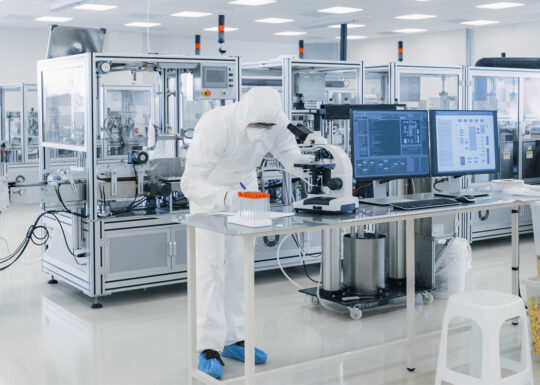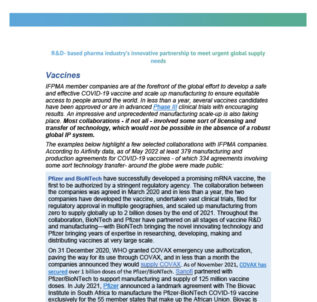Technology transfer


Technology transfer plays a role in bridging R&D gaps, increases the availability of vaccines and medicines, and stimulates investment in key industrial areas. Building on examples from our member companies, IFPMA shares the value of technology transfer with policy leaders.
Overview
The transfer of advanced technology is essential for economic development. It enables countries to accelerate the acquisition of knowledge, experience, and equipment related to advanced, innovative industrial products and processes.
Technology transfers for medicines and vaccines can bring additional, unique benefits. Many research-based pharmaceutical companies have used technology transfer to improve a country’s ability to use innovative medicines by strengthening the expertise of the local scientific and medical communities and, where possible, working to improve the health infrastructure.
Technology transfers are a complex process involving many factors and several steps. From the perspective of the pharmaceutical industry, there are 10 essential criteria that enable technology transfers that contribute to advancing global health and drive economic development in a way that’s sustainable for the broader innovation ecosystem.

Technology transfers are voluntary collaborations between businesses to exchange knowledge, know-how, and show-how to develop essential medicines and vaccines based on expertise, experience, and trust.
As pharmaceutical technology and production have become more complex, technology transfers have required a greater level of expertise, human skills, organizational and procedural knowledge, and other key tangible and intangible elements.
Experience shows that voluntary technology transfers are an effective way to cultivate transfer of manufacturing technology as well as other forms of acquired expertise.
To make sure technology transfers achieve their goal, it’s essential to understand their evolving landscape, the factors that enable success, and how different stakeholders can work together.
Creating the right conditions for the transfer of technology is an important consideration for all countries at all income levels. Many multilateral organizations, including the United Nations, the World Bank, the World Trade Organization, and the World Intellectual Property Organization, have a role to play.
We engage with these organizations and governments to support the development of policies that foster the right framework for voluntary tech transfer agreements.

Our technology transfer checklist
IFPMA has prepared a useful checklist for transferring technologies and vaccines, covering everything from the need for a rule of law to clear economic development priorities.
The role of technology transfer during the COVID-19 pandemic
Technology transfer has been fundamental to the global pharmaceutical industry’s ability to rapidly scale up production of COVID-19 vaccines and treatments.
In the first year of COVID-19 vaccines, there were over 380 manufacturing and production deals worldwide. Around 75% of these involved some sort of technology transfer.
For example, Pfizer and BioNTech successfully developed a promising mRNA vaccine for use against COVID-19 in March 2020, taking less than a year. Moderna and Lonza joined forces to support drug substance manufacturing for the global supply chain of their COVID-19 vaccine.
With COVID-19 treatments, biopharmaceutical companies have entered 138 voluntary manufacturing arrangements with partners across the world. Over 92% collaborations involved technology transfer, and 43 of these came within the first year of the pandemic.
manufacturing and production deals for COVID-19 vaccines, of which 70% involve technology transfer
manufacturing and production deals for COVID-19 therapeutics, of which 92% involve technology transfer
factors emerge as enablers for pharmaceutical technology transfers
The challenges
The transfer of pharmaceutical technology and R&D typically requires far more than sharing a “recipe” or building a bricks-and-mortar factory.
Given the complex nature of technology transfer, simply having an agreement to transfer technology does not allow for it to take place.
An effective technology transfer relies on several outside factors and on trade policies that can sometimes present obstacles, such as those we faced in developing COVID-19 vaccines and therapeutics.
Challenges include trade restrictions on upstream supply of raw materials, skilled workforce, supply chains, viable partners, cost, and method of distribution.
To overcome these, countries that receive technology transfers are encouraged to prioritize technology intensive policies and the innovation system that sustains it as a long-term objective for the nation.
Enabling technology transfers to succeed
Our publication, ‘Technology Transfer, A Collaborative Approach to Improve Global Health’, summarizes the current landscape for technology transfers, the 10 factors that enable success, and how different stakeholders can work together to deliver on prerequisites







